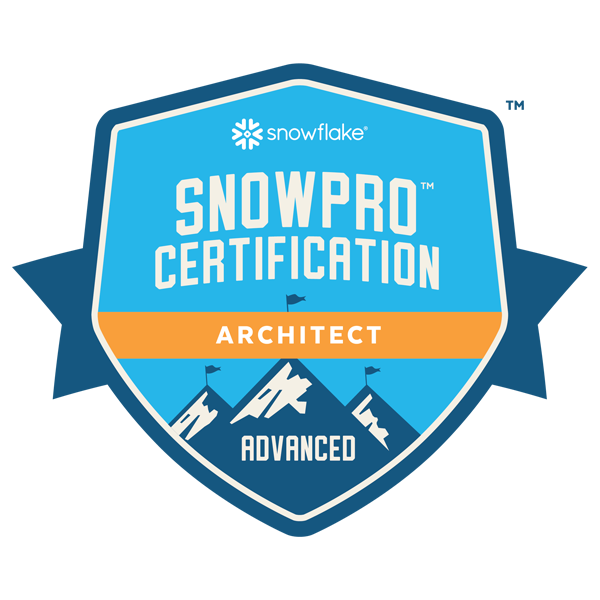Description
Introduction of SnowPro® Advanced Architect
The SnowPro® Advanced Architect certification validates expertise in designing, implementing, and optimizing large-scale data solutions using Snowflake’s cloud data platform. This training is designed for data architects, solution designers, and engineers who need to build high-performance, secure, and cost-efficient data architectures in Snowflake.
Participants will learn how to:
- Design scalable and resilient Snowflake architectures
- Implement best practices for data governance, security, and access control
- Optimize query performance and resource management
- Integrate Snowflake with external data lakes, APIs, and cloud services
- Apply real-world architectural strategies for multi-cloud, hybrid, and enterprise deployments
Prerequisites of SnowPro®
- Snowflake Core Certification or equivalent experience
- Strong knowledge of SQL, cloud data warehousing, and data modeling
- Familiarity with performance tuning, security, and access control in Snowflake
- Experience in integrating Snowflake with cloud services (AWS, Azure, GCP)
Table of Contents
1. Snowflake Architecture & Data Modeling Strategies
1.1 Snowflake’s Multi-Cluster Shared Data Architecture
1.2 Best Practices for Schema Design and Normalization
1.3 Snowflake Virtual Warehouses and Compute Optimization
1.4 Data Partitioning, Clustering, and Micro-Partitioning
1.5 Choosing the Right Storage & Compute Configuration
2. Security, Access Control & Data Governance
2.1 Role-Based Access Control (RBAC) and Privileges
2.2 Column-Level Security, Row Access Policies & Data Masking
2.3 Data Classification, Encryption, and Compliance (GDPR, HIPAA, SOC 2)
2.4 Auditing and Monitoring with Access History & Query Logging
2.5 Secure Data Sharing and Cross-Account Data Governance
3. Performance Optimization & Cost Management
3.1 Query Performance Tuning & Profiling(Ref: SnowPro® Advanced Data Engineer Training)
3.2 Materialized Views, Result Caching, and Query Acceleration
3.3 Warehouse Auto-Suspend, Auto-Scaling, and Concurrency Best Practices
3.4 Resource Monitoring and Query Performance Diagnostics
3.5 Cost Optimization Strategies for Large-Scale Workloads
4. Data Ingestion, Transformation & Processing
4.1 Ingesting Data with Snowpipe, External Tables & Stages
4.2 Batch vs. Streaming Data Processing in Snowflake
4.3 Automating ELT with Streams, Tasks, and Stored Procedures
4.4 Handling Semi-Structured Data (JSON, Parquet, Avro)
4.5 Using Snowpark for Advanced Transformations and Processing
5. Enterprise Data Integration & API Connectivity
5.1 Federated Queries and Cross-Cloud Data Access
5.2 Snowflake Integration with Cloud Storage (S3, Azure Blob, GCS)
5.3 External Functions and API Integration (AWS Lambda, GCP Functions)
5.4 Hybrid Cloud & Multi-Cloud Data Architectures
5.5 Third-Party Tool Integration (ETL, BI, Machine Learning)
6. Advanced Data Sharing & Business Continuity
6.1 Secure Data Sharing & Cross-Region Replication
6.2 Implementing Failover & Disaster Recovery in Snowflake
6.3 Time Travel, Zero-Copy Cloning & Data Recovery Strategies
6.4 Managing Snowflake Marketplace & External Data Collaboration
6.5 Implementing Data Contracts and SLAs for Shared Data
7. Snowflake Automation & DevOps Best Practices
7.1 Infrastructure as Code (IaC) with Terraform and Snowflake
7.2 CI/CD Pipelines for Snowflake Schema & Code Deployment
7.3 Automating Schema Evolution & Data Pipeline Orchestration
7.4 Version Control and Change Management in Snowflake
7.5 Monitoring & Alerting for Snowflake Workloads
8. Real-World Use Cases & Hands-On Labs
8.1 Designing a Scalable Enterprise Data Warehouse in Snowflake
8.2 Building an End-to-End Data Pipeline for AI/ML Use Cases
8.3 Implementing Cross-Cloud Data Architecture for Global Enterprises
8.4 Cost-Optimized Design for High-Concurrency Workloads
8.5 Capstone Project: Snowflake Data Architecture Blueprint
9. SnowPro® Advanced Architect Certification Preparation
9.1 Exam Structure and Key Domains Covered
9.2 Advanced Architectural Scenarios and Case Studies
9.3 Performance-Based Questions and Best Practices
9.4 Sample Exam Questions and Practice Tests
9.5 Final Mock Exam & Review
Conclusion
The SnowPro® Advanced Architect training equips professionals with the skills to design scalable, high-performance, and secure Snowflake data solutions. By mastering advanced architecture, security, and optimization strategies, participants will be ready to pass the certification exam and effectively architect enterprise-scale solutions in Snowflake. This training ensures data architects and engineers can maximize Snowflake’s capabilities to support modern data workloads efficiently.








Reviews
There are no reviews yet.